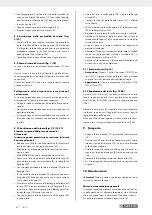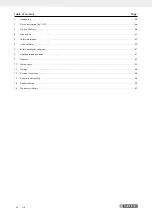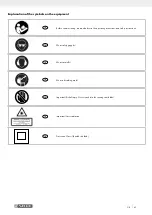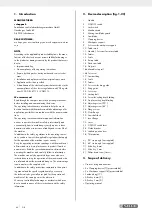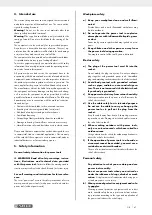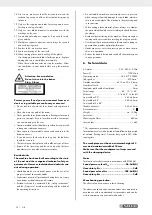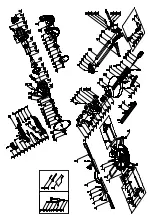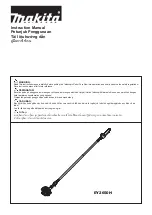
54
GB
Cleaning the moving saw blade guard safety
device (5)
Always check the saw blade guard for debris before using the
machine.
Remove old sawdust and splinters using a brush or similar
tool.
Replacing the table insert
Danger!
• With a damaged table insert (10) there is a risk of small
parts getting stuck between table insert and saw blade,
blocking the saw blade.
Immediately replace damaged table inserts!
1. Remove screws at table insert. If required, turn rotary table
and incline saw head to be able to reach the screws.
2. Remove table insert.
3. Install new table insert.
4. Tighten the screws at table insert.
Brush inspection
Check the carbon brushes after the first 50 operating hours
with a new machine, or when new brushes have been fitted.
After carrying out the first check, repeat the check every 10
operating hours.
If the carbon is worn to a length of 6 mm, or if the spring or
contact wire are burned or damaged, it is necessary to replace
both brushes. If the brushes are found to be usable following
removal, it is possible to reinstall them.
When servicing the carbon brushes, open the two latches coun-
terclockwise (as shown in Figure 21). Then remove the carbon
brushes.
Replace the carbon brushes in the reverse order.
11. Storage
Store the device and its accessories in a dark, dry and frost-
proof place that is inaccessible to children. The optimum stor-
age temperature is between 5 and 30˚C.
Store the electrical tool in its original packaging.
Cover the electrical tool in order to protect it from dust and
moisture.
Store the operating manual with the electrical tool.
12. Electrical connection
The electrical motor installed is connected and
ready for operation. The connection complies with
the applicable VDE and DIN provisions.
The customer‘s mains connection as well as the ex-
tension cable used must also comply with these
regulations.
• The product meets the requirements of EN 61000-3-11 and
is subject to special connection conditions. This means that
use of the product at any freely selectable connection point
is not allowed.
• Given unfavourable conditions in the power supply the prod-
uct can cause the voltage to fluctuate temporarily.
• The product is intended solely for use at connection points
that
a) do not exceed a maximum permitted supply impedance
“Z” (Zmax = 0.382 Ω), or
b) have a continuous current-carrying capacity of the mains
of at least 100 A per phase.
• As the user, you are required to ensure, in consultation with
your electric power company if necessary, that the connec-
tion point at which you wish to operate the product meets
one of the two requirements, a) or b), named above.
Important information
In the event of an overloading the motor will switch itself
off. After a cool-down period (time varies) the motor can be
switched back on again.
Damaged electrical connection cable.
The insulation on electrical connection cables is often dam-
aged.
This may have the following causes:
• Passage points, where connection cables are passed
through windows or doors.
• Kinks where the connection cable has been improperly fas-
tened or routed.
• Places where the connection cables have been cut due to
being driven over.
• Insulation damage due to being ripped out of the wall out-
let.
• Cracks due to the insulation ageing.
Such damaged electrical connection cables must not be used
and are life-threatening due to the insulation damage.
Check the electrical connection cables for damage regularly.
Make sure that the connection cable does not hang on the
power network during the inspection.
Electrical connection cables must comply with the applicable
VDE and DIN provisions. Only use connection cables with the
marking „H05VV-F“.
The printing of the type designation on the connection cable
is mandatory.
AC motor:
The mains voltage must be 220 - 240 V~.
• Extension cables up to 25 m long must have a cross-section
of 1.5 mm
2
.
Connections and repairs of electrical equipment may only be
carried out by an electrician.
Please provide the following information in the event of any
enquiries:
• Type of current for the motor
• Machine data - type plate
13. Disposal and recycling
The equipment is supplied in packaging to prevent it from be-
ing damaged in transit. The raw materials in this packaging
can be reused or recycled. The equipment and its accesso-
ries are made of various types of material, such as metal and
plastic. Defective components must be disposed of as special
waste. Ask your dealer or your local council.
Summary of Contents for PZKS 2000 A1
Page 5: ...16 17 18 19 15 20 21 22 5 29 34 31 33 30 28 C 6 17 32 32a 32b E E E 32b...
Page 61: ...56 GB...
Page 63: ...58...
Page 65: ......
Page 66: ......
Page 67: ......

